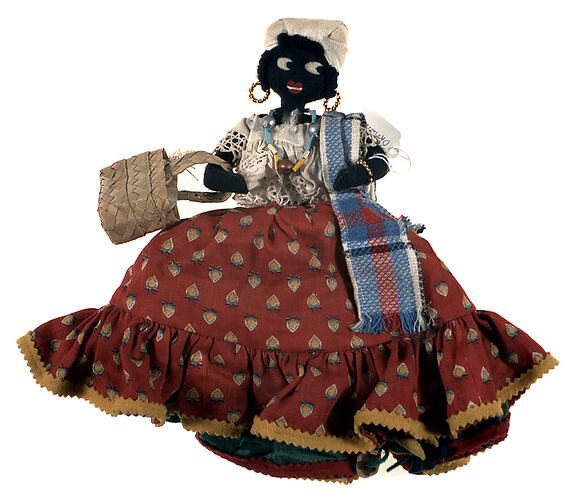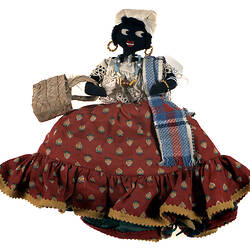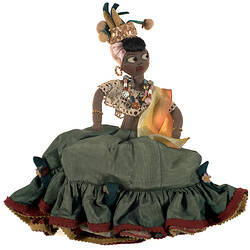Summary
Note: This object is a cultural stereotype. Such representations are not condoned by Museums Victoria which considers them to be racist. Historical distance and context do not excuse or erase this fact.
National doll produced to represent a Brazilian woman. It was given to Monica Gates circa1960 by a friend of her mother's who purchased the doll in 1959; she owned a coffee plantation in Brazil until she moved to Australia in 1960. The doll is reversible. The doll features two recognisable representations of Brazilian women, both of which became part of Brazilian popular culture during the 1930s and 1940s.
The doll's costume with the white lace blouse and turban is a typical representation of an Afro-Brazilian Bahiana (Baiana) woman who could often be found selling food on the street. The lacy white garments and colourful beads she wore are associated with adepts of the candomblé religion, a mix of African, Catholic and some beliefs and traditions of peoples Indigenous to North America (the terms Native American and American Indian are also used by government and cultural institutions in the USA).
This same representation of the Bahiana woman is the inspiration for the costume worn by the other doll. Within Brazil the image of the Bahiana became part of popular culture and Brazilian identity through its use as a carnaval costume during the 1920s and 1930s. It was further popularised and promoted as a symbol of Brazilian identity, both in Brazil and internationally, by Brazilian entertainer Carmen Miranda. Miranda's costumes with their frills, bare shoulders and/or midriff's, and the turban laden fruit, were simply an exaggerated stylization of the Bahiana woman. Internationally these costumes became a symbol of Brazilian and to an extent Latin America culture and identity during the 1940s and 1950s.
The Gates collection contains 170 national dolls from 74 different countries and some correspondence relating to the acquisition of several of the dolls. The costumes of the dolls represent national costumes from the 19th Century to the 1990s. Monica Gates collected or was given these dolls between 1957 and 1990.
These dolls were purchased as souvenirs of particular countries and like many mass produced souvenirs they are often not accurate representations of a particular country or region, and may actually better reflect neighbouring counties or regions. This occurs because costumes are often stylised and simplified resulting dolls wearing generic costume elements which are common to many countries/regions. Often the fabrics and decorations used are selected to make the dolls cheap and easy to manufacture and aesthetically pleasing. This can result in the fabrics, colours and decorations of the doll's clothing having little or no reflection of the costume associated with a particular country or region they are meant to be representative of.
Physical Description
Reversible doll with two female characters. The first has a basket of fruit on her head which contains a felt pineapple and felt bananas as well as some other types of fruit. Felt has been sewn on for the eyes and mouth and further stitches have been used to delineate the eye-brows and lashes. Her jewlery consists of gold loop earrings with matching bracelets on either wrist. Around her neck she wears two beaded necklaces. Her top is made of an open weave lace type material which comes to were her navel would be. Over her should she has a yellow and orange sash. Her skirt olive green with red trimming. It is quite puffy and has a ruffle at the bottom which has felt flowers at regular intervals around the top of it. The reverse doll, which appears when the skirt of the first doll is lifted over her head, has her hair tied up and covered with a cream scarf. Her face is made in a similar fashion to the first doll. Her jewlery too is similar, however, she has only one bracelet and one necklace. Her top is cream and her skirt is red and patterned. She has a red, blue and white scarf over her shoulder.
More Information
-
Collecting Areas
-
Acquisition Information
Purchase
-
Place Made
-
User
-
Other Association (See Comments)
Brazil
Doll is wearing clothing which is associated with Brazil. -
Classification
-
Category
-
Discipline
-
Type of item
-
overall dimensions
30 cm (Length), 14 cm (Width), 30 cm (Height)
-
Keywords
Children's Play, Clothing, Cultural Awareness, Cultural Beliefs, Dolls, National Costumes, National Identity, Souvenirs


